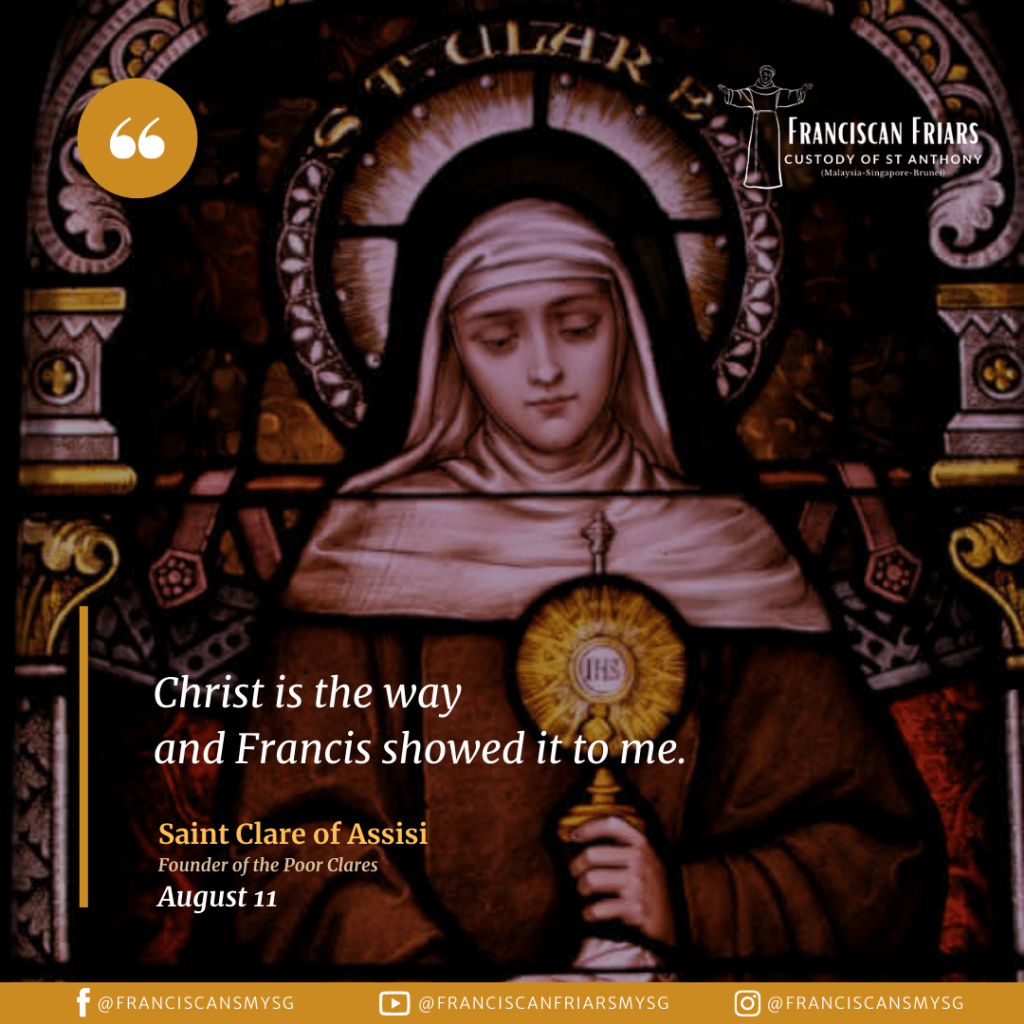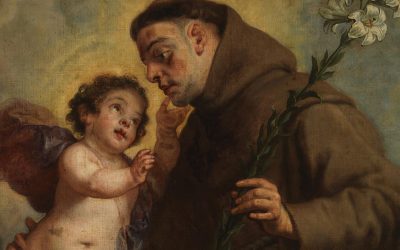
The story of St. Clare of Assisi is inevitably linked with St. Francis, the one she called her Father, Planter, and Helper in the Service of Christ. It was Francis who gave her a vision and enabled her to define a way of life apart from the options offered her by society. But her goal in life was not to be a reflection of Francis but to be, like him, a reflection of Christ. “Christ is the way,” she said, “and Francis showed it to me.”
Like Francis, Clare belonged to one of the wealthy families of Assisi. Like every- one else in the town, she was aware of the remarkable spectacle that Francis had made in abandoning his respectable family and assuming the poverty of a beggar. Doubtless there were those in Assisi who respected Francis as a faithful Christian, just as there were others who believed he was a misguided fool. It was bad enough that a man of his background was tramping about the countryside, repairing aban- doned churches with his bare hands and ministering to the poor and sick. But within a few years, he had begun attracting some of the most distinguished young men of the town to follow him in his brotherhood.
She crept out a back door, slipped through the gates of Assisi, and made her way through the dark fields and olive groves…
What Clare’s family thought of all this is not known. But we know what impact it had on Clare. She heard Francis deliver a series of Lenten sermons in 1212, when she was eighteen. She arranged in stealth to meet with Francis and asked his help that she too might live “after the manner of the holy Gospel.” On the evening of Palm Sunday, while her family and all the town slept, she crept out a back door, slipped through the gates of Assisi, and made her way through the dark fields and olive groves to a rendezvous with Francis and his brothers at the chapel of St. Mary of the Angels. Before the altar, she put off her fine clothes and assumed a penitential habit, while Francis sheared off her long hair as a sign of her espousal to Christ.
It is tempting to read into this episode the romance of a spiritual elopement. To understand Clare, however we must realize that it was not Francis whom she rushed to meet in the night. He provided the meeting place, but her assignation was with Christ. Yet after Clare had taken the plunge of rejecting her family and her social station, it was not clear what the next step should be. Apparently neither Clare nor Francis had considered that far ahead. Although she wished to identify with Francis’s community, it was not seemly that she should live with the brothers. Francis arranged for her to spend the night in a nearby Benedictine convent.
Her family and a company of angry suitors tracked her down some days later in Holy Week. When pleading proved fruitless, they laid hands on her and tried to drag her out by force. She finally stopped them short by tearing off her veil and revealing her shorn head. They were too late. She was already “one of them.”
Francis had long intended that a community of women, corresponding to his fraternity, should be established. In Clare he had found the partner he was seeking. She was easily persuaded to found a women’s community, which was established at San Damiano. It required considerably more effort by Francis to persuade her to serve as abbess. Nevertheless, Clare quickly attracted other women. Over time, these included a number of her personal relatives, including her sister Catherine and even her widowed mother. Within her lifetime, additional communities were established elsewhere in Italy, France, and Germany. Among her surviving writings are a series of moving letters to St. Agnes of Prague, a young princess who joined the movement and became one of Clare’s most beloved daughters.
Unlike the friars, the Poor Ladies, as they were originally known, lived within an enclosure. But Clare shared Francis’s passionate commitment to “Lady Poverty.” For her this meant literal poverty and insecurity—not the luxurious “spiritual poverty” enjoyed by so many other convents, richly supported by gifts and endow- ments. To defend this “privilege of poverty,” Clare waged a continuous struggle against solicitous prelates who tried to mitigate her austerity. This was the center- piece of the rule she devised for her community. When the pope offered to absolve her from her rigorous vow of poverty, she answered, “Absolve me from my sins, Holy Father, but not from my wish to follow Christ.” Two days before her death in 1253, she enjoyed the grace of receiving from Rome a copy of her rule embellished with the approving seal of Pope Innocent IV. A notation on the original document notes that Clare, in tearful joy, covered the parchment with kisses.
It was Clare who urged him to go into the world: “God did not call you for yourself alone but also for the salvation of others.
It has been said that of all the followers of Francis, Clare was the most faithful. Many stories reflect the loving bonds of friendship between them and the trust that Francis placed in her wisdom and counsel. According to one story, Francis put the question to Clare whether he should preach or devote himself to prayer. It was Clare who urged him to go into the world: “God did not call you for yourself alone but also for the salvation of others.” When Francis received the stigmata, Clare thoughtfully made him soft slippers to cover his wounded feet. During a period of dejection, Francis camped out in a hut outside the convent at San Damiano. It was there that he composed the “Canticle of the Creatures,” his exultant hymn to the universe.
Finally, as Francis felt the approach of Sister Death, Clare too became seriously ill. She suffered terribly at the thought that they would not meet again in this life. Francis sent word that she should put aside all grief for she would surely see him again before her death. And so the promise was fulfilled, though not as she had wished. After Francis’s death, the brothers carried his body to San Damiano for the sisters to say their goodbyes. Thomas of Celano records that at the sight of Francis’s poor and lifeless body, Clare was “filled with grief and wept aloud.”
Francis was canonized a mere two years later. Clare lived on for another twenty- seven years. In her own final “Testament,” written near the end of her life, Clare makes only a discrete reference to the pain of their separation and what it meant to her: “We take note…of the frailty which we feared in ourselves after the death of our holy Father Francis. He was our pillar of strength and, after God, our one conso- lation and support. Thus time and again, we bound ourselves to our Lady, most Holy Poverty.”
As she lay dying at San Damiano, Clare offered her final blessing to the daughters gathered beside her: “May the Lord bless you and keep you. May He show his face to you and be merciful to you. May He turn his countenance to you and give you peace.”
St. Clare died on August 11, 1253. She was canonized in 1255.
Source : The Franciscan Saints (Franciscan Media)





0 Comments